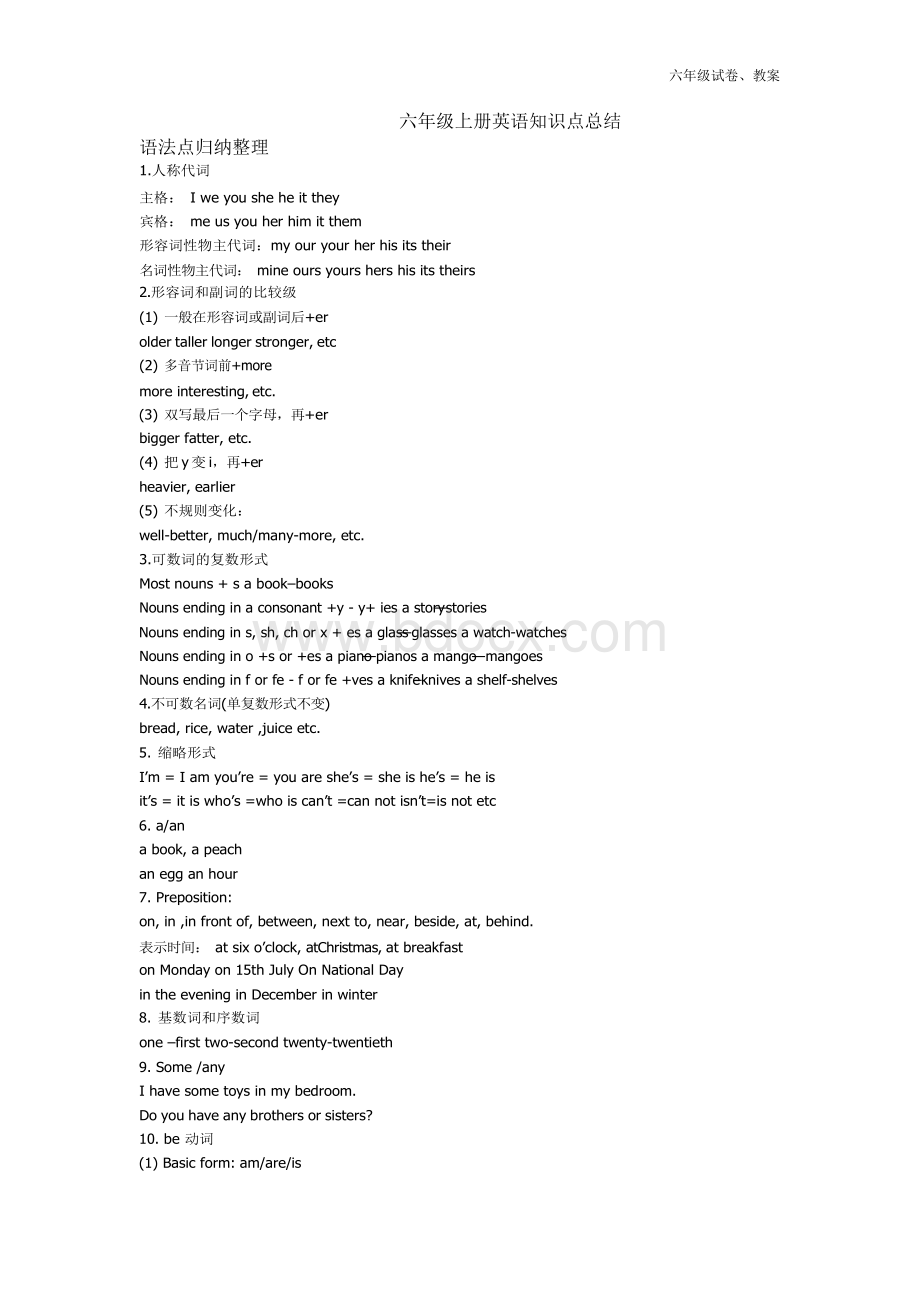六年级上册英语知识点总结.docx
《六年级上册英语知识点总结.docx》由会员分享,可在线阅读,更多相关《六年级上册英语知识点总结.docx(16页珍藏版)》请在冰豆网上搜索。

六年级试卷、教案
六年级上册英语知识点总结
语法点归纳整理
1.人称代词
主格:
Iweyousheheitthey
宾格:
meusyouherhimitthem
形容词性物主代词:
myouryourherhisitstheir
名词性物主代词:
mineoursyourshershisitstheirs2.形容词和副词的比较级
(1)一般在形容词或副词后+eroldertallerlongerstronger,etc
(2)多音节词前+moremoreinteresting,etc.
(3)双写最后一个字母,再+er
biggerfatter,etc.
(4)把y变i,再+erheavier,earlier
(5)不规则变化:
well-better,much/many-more,etc.3.可数词的复数形式
Mostnouns+sabook–books
Nounsendinginaconsonant+y-y+iesastor—ystories
Nounsendingins,sh,chorx+esaglas—sglassesawatch-watchesNounsendingino+sor+esapian—opianosamango—mangoesNounsendinginforfe-forfe+vesaknife–knivesashelf-shelves4.不可数名词(单复数形式不变)
bread,rice,water,juiceetc.
5.缩略形式
I’m=Iamyou’re=youareshe’s=sheishe’s=heisit’s=itiswho’s=whoiscan’t=cannotisn’t=isnotetc
6.a/an
abook,apeachanegganhour
7.Preposition:
on,in,infrontof,between,nextto,near,beside,at,behind.
表示时间:
atsixo’clock,atChristmas,atbreakfastonMondayon15thJulyOnNationalDay
intheeveninginDecemberinwinter
8.基数词和序数词
one–firsttwo-secondtwenty-twentieth
9.Some/any
Ihavesometoysinmybedroom.Doyouhaveanybrothersorsisters?
10.be动词
(1)Basicform:
am/are/is
(2)肯定和否定句Iam(not)fromLondon.Myeyesare(not)small.
Myhairis(not)long.
(3)一般疑问句:
AmIaChniese?
Yes,youare.No,youaren’t.AretheyAmerican?
Yes,theyare.No,theyaren’t.
Isthecatfat?
Yes,itis.No,itisn’t.
11.therebe结构
肯定句:
Thereisa…Thereare…
一般疑问句:
Isthere…?
Yes,thereis./No,thereisn’t.Arethere…?
Yes,thereare./No,therearen’t.
否定句:
Thereisn’t….Therearen’t….
12.祈使句
Sitdownplease
Don’tsitdown,please.
13.现在进行时.通常用“now”.
形式:
be+verb+ing
eg:
Iam(not)doingmyhomework.You/We/Theyare(not)reading.
He/She/Itis(not)eating.
动词—ing的形式
Mostverbs+ingwalk—walking
Verbsendingine-e+ingcom—ecoming
Shortverbsendinginavowel+aconsonantrun–runningswim—swimming14一般现在时。
通常用“usually,often,everyday,sometimes。
”
肯定句:
Igotoschoolonfooteveryday.
Shegoestoschoolonfooteveryday.
一般疑问句:
Doyoujumphigh?
Yes,Ido./No,Idon’t.
Doeshejumphigh?
Yes,hedoes./No,hedoesn’t.
否定句:
Wedon’tgotoschoolonSundays.
Mymotherdoesn’tlikewatchingTVintheevening.
15.(情态)动词can,must,should后面直接用动词原形。
eg:
1.I/He/She/Theycansing.
2.Youshouldkeepquietinthelibrary.
16.一般过去时态
(a)be动词的过去式:
I/He/she/itwas(not)….You/we/theywere….
一般疑问句was,were放在句首。
(b)动词过去式:
肯定句:
Iwatchedcartoons.
Shevisitedthezoo.
一般疑问句:
Didyoureadbooklastnight?
Yes,Idid.No,Ididn’t.Didshecleanthedeskjustnow?
Yes,shedid.No,shedidn’t.
否定句:
Theydidn’tgothethepartyesterday.Hedidn’tmakemodelshipslastweek.
(c)动词过去式的变化:
规则动词的变化:
Mostverbs+edeg.planted,watered,climbe。
dVerbsendingine+degliked。
Verbsendinginaconsonant+y--y+iedeg:
stud—ystudiedShortverbsendinginavowel+aconsonanteg:
stop--stopped
不规则动词的变化:
is/am—was,are—were,do—did,have/has—had,make—made,fly-flew/u:
/eat—ate,take—took,run—ran,sing—sang,drink—drank等等
17.“Wh-”questions.Whatareyoudoing?
Whatcolourisit?
Whichisyourwatch,theyellowoneorthewhiteone?
顺便整理一下~~!
小学六年级英语语法要点归纳!
一、名词复数规则
1.一般情况下,直接加-s,如:
book-books,bag-bags,cat-cats,bed-beds
2.以s.x.sh.ch结尾,加-es,如:
bus-buses,box-boxes,brush-brushes,watch-watches3.以“辅音字母+y”结尾,变y为i,再加-es,如:
family-families,strawberry-strawberries
4.以“f或fe”结尾,变f或fe为v,再加-es,如:
knife-knives5.不规则名词复数:
man-men,woman-women,policeman-policemen,policewoman-policewomen,mouse-micechild-childrenfoot-feet,.tooth-teethfish-fish,people-people,Chinese-Chinese,Japanese-Japanese
二、一般现在时
1.一般现在时表示经常或习惯性的动作,也可表示现在的状态或主语具备的性格和能力。
2.一般现在时中,没有be动词和情态动词,主语为第三人称单数的肯定句,动词要按规则加上s,主语是非第三人称单数的肯定句,动词用原形。
3.在一般现在时中,句中有be动词或情态动词时,否定句在be动词和情态动词后加not,一般疑问句将be动词或
情态动词放在句首。
4.在一般现在时中,句中没有be动词或情态动词时,主语为第三人称单数的否定句在动词前加does+not(doesn’t),一般疑问句在句首加does,句子中原有动词用原形;主语为非第三人称单数,否定句用do+not(don’t),一般疑问句在句首加do,句子中动词用原形。
动词+s的变化规则
1.一般情况下,直接加-s,如:
cook-cooks,milk-milks
2.以s.x.sh.ch.o结尾,加-es,如:
guess-guesses,wash-washes,watch-watches,go-goes3.以“辅音字母+y”结尾,变y为i,再加-es,如:
study-studies三、现在进行时
1.现在进行时表示现在正在进行或发生的动作,也可表示当前一段时间内的活动或现阶段正在进行的动作。
名词可以分为专有名词(ProperNouns)和普通名词(CommonNouns),专有名词是某个
(些)人,地方,机构等专有的名称,如Beijing,China等。
普通名词是一类人或东西或是一个抽象概念的名词,如:
book,sadness等。
普通名词又可分为下面四类:
1)个体名词(IndividualNouns):
表示某类人或东西中的个体,如:
gun。
2)集体名词(CollectiveNouns):
表示若干个个体组成的集合体,如:
family。
3)物质名词(MaterialNouns):
表示无法分为个体的实物,如:
air。
4)抽象名词(AbstractNouns):
表示动作、状态、品质、感情等抽象概念,如:
work。
个体名词和集体名词可以用数目来计算,称为可数名词(CountableNouns),物质名词和抽象名词一般无法用数目计算,称为不可数名词(UncountableNouns)
一般情况 加-s
1.清辅音后读/s/; map-maps
2.浊辅音和元音后读/z/; bag-bagscar-cars
以s,sh,ch,
x等结尾的词加-es读/iz/bus-buses watch-watches
以ce,se,ze,(d)ge等结尾的词加-s